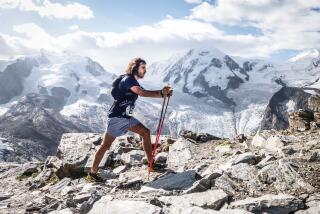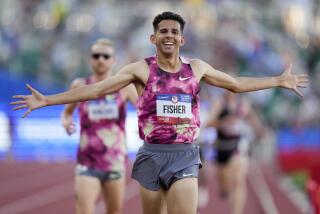Smyth Enjoying the Lead in Pacific 1000 Race but . . . : Sailing Not So Smooth for Rest of Field
- Share via
One competitor has broken ribs, a beach volunteer has a broken arm, sails have ripped and rudders have broken, but Randy Smyth keeps sailing along.
“It was a gorgeous sail around Catalina,” said Smyth, the runaway leader of the Pacific 1000 catamaran race off the Southern California coast. “San Clemente Island looked like it was cut out of a piece of paper.”
The 1,000-mile race reaches its northern turning point on the run from Oxnard to Santa Barbara today and is scheduled to finish at Huntington Beach Sunday. When it’s over, it appears, Smyth will have reinforced his status as the world’s dominant multihull sailor.
The first eight days around Catalina and to San Diego and back have seen varying wind strengths, and the 32-year-old Huntington Beach sailmaker, with Jim Hill of San Francisco as crew, seems to be fastest in all conditions.
“The most hair-raising, dangerous part was launching at Doheny Beach (in Dana Point last Sunday),” Smyth said during the stopover at Redondo Beach, when eight of the original 11 boats remained.
Each day’s leg starts with a “LeMans” start through the surf, which sometimes crests to 10 feet.
“The worst thing about it was there was no wind,” Smyth said, “and what wind there was was straight on the beach. You had to time it just right to outsmart the sets of waves. Jim was on the bow of our boat when a wave just lifted the boat up. He was hanging by his hands, and his feet were out of the water.”
A rudder snapped when the boat hit bottom, forcing Smyth to return to the beach for a quick replacement. But he was one of the lucky ones.
A local resident, Jason Golding, 14, was helping to push John Main’s boat out through the surf when he slipped and broke an arm.
His mother told Main: “He didn’t quit on you. He got hurt.”
Larry Harteck of Santa Barbara tried once and broke both rudders. He tried again and broke another rudder. On his third try he broke free of the surf. Australia’s Dave Renouf had his craft flip over backwards.
“We were lucky that the lifeguards and paramedics were there and we had a lot of people to help out,” Smyth said.
Later, Main broke a rib or two--he wasn’t sure how many--when a wave knocked him against a hull and he had to drop out for a couple of days, vowing to rejoin the race before it was over.
The longest ordeal was suffered by the three-woman crew of Stephanie Elliott of Newport Beach; Theresa Funaro of Seal Beach, and Diana Riggs of Long Beach. On Monday’s leg from San Diego to Newport Beach the wind died at Dana Point and they didn’t reach shore until 6:30 a.m. Tuesday--20 1/2 hours on the water and nine hours after Smyth.
But by 10 a.m. they were ready to start the next leg to Redondo Beach, where they drifted in well behind their seven remaining male rivals.
Elliott’s husband, Skip, a Newport Beach sailmaker, said: “They were a little tired but in pretty good spirits.
“They were smart. They knew they were going to be late, so they took the spinnaker and wrapped themselves up and were able to get a little sleep. When they got in I grabbed Stephanie off the boat, took her home and told her to take a hot shower and go to bed.”
The next morning he cooked breakfast for the crew and sent them on their way.
The women’s boat capsized on the previous leg to San Diego.
“It was a good experience,” Skip Elliott said. “They lost a little time getting it righted, but they’ll pay attention now.”
Promoter John Taylor said: “When we decided to put a women’s team in the event we got a backlash chauvinist attitude: ‘You’re just trying to exploit ‘em, because there’s no way they can do it.’
“I said, ‘Don’t tell that to the girls. They’re taking it real seriously.’
“I was shocked at 10 minutes to 10 Tuesday morning when they walked out on one hour’s sleep after being out all night, freezing cold, (with) no food, and here they are (facing) eight hours upwind.
“If they can finish the event . . . probably only five or six teams are gonna be able to say they did.”
Stephanie Elliott said: “We really wanted to be competitive, but we’ll be pleased to finish in one piece. We’re scared about the heavy-air reaches, so we’re going to sail conservatively. It’s just good old-fashioned inexperience.”
Besides Main’s injury, two teams have been forced out by breakdowns.
Harteck, in third place, still is in the running but said: “Every day we’ve had bad luck.”
Besides breaking three rudders at Doheny Beach, he said Tuesday: “We blew out our big reacher (sail)--the seams split--and we had to go with a smaller one, which was not the proper sail to have because the air was light.
“Today we had our small one up to start with because we knew the wind was gonna build, and 20 minutes into the race it split. We had to put up the big one, which was the wrong sail to have, so . . . “
Renouf, who placed second in the Worrell 1000 on the East Coast earlier this year, got hung up on the kelp beds off the Palos Verdes peninsula.
“I didn’t run into it,” he said. “I parked on top of it.”
A rival said, “He was trying to make a salad.”
Renouf escaped when he “lifted the boards up and paddled it off.”
The U.S. Marine Corps entry was not doing well, being overmatched in equipment and experience. The skipper is Lance Cpl. Mike Christensen of Ft. Lauderdale, Fla., with civilian Joe Walker as crew.
Not knowing any better, they started the event without wet suits and food on board, somewhat less prepared than their rivals.
“A lot less,” Christensen said. “We don’t have nothin’. But it’s been great. The whole thing has been an experience. The dark and the sharks were all I was worried about. But we’ve had a great time. I’m just trying to keep up with the big guys.
“I was kind of bummed yesterday . . . sailed in the dark and didn’t get in until 2:45 (a.m.). No wind at all. Just drifted around for hours. Then to get up this morning and meet this, I really didn’t want to do it, but after an hour it was great. I’m going to do it again.”
Nobody reported a serious encounter with sharks or large ships, although several sharks and ships have been sighted.
Harteck’s crew, Eric Brinton of San Diego, said: “We could see some boats going by, but they’re well lit. When we got off the beach (at Newport), it was dense fog and we heard a ship tooting its horn, then we could hear its engines, and then we saw it pass by a couple of hundred yards away.”
Smyth said: “After we came out of the fog we never saw anybody all day. We’ve seen a few sharks and flying fish . . . a lot of flying fish out there. The sharks are just curious. The Marines saw one that was as big as their boat.”
Smyth, who often seems to be a jump ahead of his rivals technologically, is sailing with a radical elliptical “wing” mast fabricated from wood and carbon fiber by Bob DeLong of R.D. Boatworks in Capistrano Beach.
“Upwind you’ve got a lot better shape,” Smyth said. “It’s actually an extension of the sail. And the beauty of it is that just by changing the mast rotation you can trim your sail into being full or flat. Downwind you rotate it a lot and get a highly cambered, very full sail.”
Smyth, with regular crew Jay Glaser, won the Worrell 1000 in record time last year and in 1988 intends to make another bid for the Olympic gold medal that eluded him in ’84 in an upset loss to New Zealand’s Rex Sellers and Christopher Timms.
“We’ve beaten them handily in every regatta since,” he said.
The Pacific 1000, Smyth said, is more interesting than the Worrell.
“It’s a lot more scenic and a lot more creative. The East Coast is flat, with nothing but white sand beaches for the whole thousand miles . . . a straight-line deal. This has a lot more variety, going around islands and points of land.”
It is expected to get especially interesting Friday when the fleet leaves Santa Barbara to sail around Santa Cruz Island to Oxnard. Taylor said he has had reports of 10-foot seas in the area and that the boats will be watched over by an 82-foot Coast Guard vessel, a helicopter, two fixed wing aircraft and two small chase boats.
“We expect a few boats to break up,” he said.
Skip Elliott, expressing concern for his wife, said he planned to join the accompanying fleet.
“You’re always concerned,” Elliott said. “I’d be a fool if I wasn’t.
“But the day they sailed back from Catalina it was blowing pretty hard and they handled it. I’m convinced they know what they’re doing. Their whole thing is just to finish it. I’m impressed with their attitude. They know they’re behind, but they don’t give up.”
More to Read
Go beyond the scoreboard
Get the latest on L.A.'s teams in the daily Sports Report newsletter.
You may occasionally receive promotional content from the Los Angeles Times.










